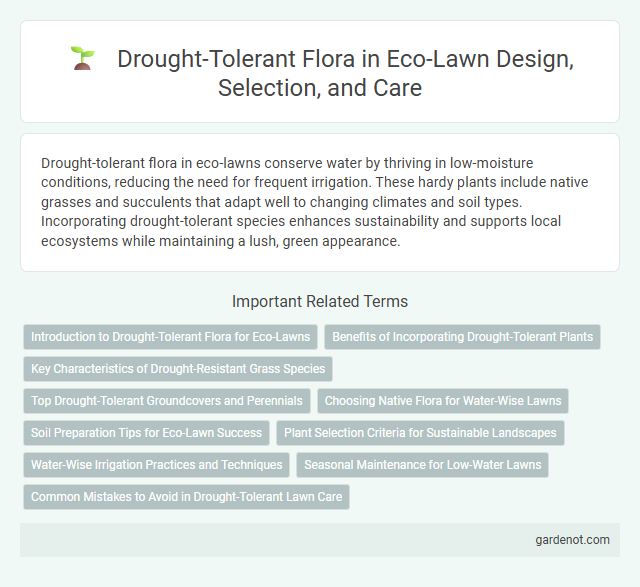Drought-tolerant flora in eco-lawns conserve water by thriving in low-moisture conditions, reducing the need for frequent irrigation. These hardy plants include native grasses and succulents that adapt well to changing climates and soil types. Incorporating drought-tolerant species enhances sustainability and supports local ecosystems while maintaining a lush, green appearance.
Introduction to Drought-Tolerant Flora for Eco-Lawns
Drought-tolerant flora, such as Buffalo grass (Bouteloua dactyloides) and Blue grama (Bouteloua gracilis), are ideal for eco-lawns due to their minimal water requirements and deep root systems that enhance soil retention. These native grasses and groundcovers reduce irrigation needs, promote biodiversity, and withstand prolonged dry periods without compromising lawn health. Integrating species like Creeping thyme (Thymus serpyllum) and Zoysia grass further optimizes water conservation while maintaining aesthetic appeal.
Benefits of Incorporating Drought-Tolerant Plants
Incorporating drought-tolerant plants into an eco-lawn significantly reduces water consumption, promoting sustainable landscape management. These flora species enhance soil health by minimizing erosion and improving moisture retention, leading to lower maintenance costs over time. Their resilience to dry conditions supports biodiversity by providing habitat for native pollinators and wildlife.
Key Characteristics of Drought-Resistant Grass Species
Drought-tolerant grass species exhibit deep root systems, enabling efficient water absorption and retention during prolonged dry periods. These grasses often have narrow, tough blades with waxy coatings that reduce transpiration and water loss. Key examples include buffalo grass, Bermuda grass, and fescues, all known for their resilience in arid conditions and minimal irrigation needs.
Top Drought-Tolerant Groundcovers and Perennials
Top drought-tolerant groundcovers such as creeping thyme, sedum, and blue star creeper excel in eco-lawn settings by minimizing water use while maintaining vibrant coverage. Perennials like lavender, yarrow, and Russian sage thrive under drought conditions, offering resilient foliage and prolonged blooming periods that reduce irrigation needs. Integrating these species into eco-lawns enhances sustainability, conserves water resources, and supports biodiversity in xeriscape landscapes.
Choosing Native Flora for Water-Wise Lawns
Selecting drought-tolerant native flora for eco-lawns enhances water conservation by minimizing irrigation needs and promoting local biodiversity. Native species like buffalo grass, blue grama, and fine fescues are adapted to regional climates, ensuring resilience during dry spells and reducing maintenance. Incorporating these plants supports sustainable landscaping, improves soil health, and fosters a balanced ecosystem.
Soil Preparation Tips for Eco-Lawn Success
Incorporating drought-tolerant flora into eco-lawns demands careful soil preparation to enhance water retention and root penetration. Amending soil with organic matter such as compost improves moisture-holding capacity and nutrient availability, creating an optimal growing environment for resilient grasses like buffalo grass and native fescues. Ensuring proper soil aeration and pH balance supports sustainable growth and minimizes irrigation needs, key factors for long-lasting eco-lawn success in drought-prone areas.
Plant Selection Criteria for Sustainable Landscapes
Drought-tolerant flora selection for eco-lawns prioritizes native species with deep root systems and low water requirements, enhancing landscape resilience and reducing irrigation needs. Key criteria include adaptability to local soil conditions, minimal maintenance demands, and capacity to thrive under prolonged dry periods, ensuring sustainability. Plant choices such as buffalo grass, blue grama, and sedum contribute significantly to water conservation and ecosystem balance.
Water-Wise Irrigation Practices and Techniques
Drought-tolerant flora in eco-lawns require strategic water-wise irrigation practices such as drip irrigation and soil moisture sensors to optimize water usage while minimizing waste. Implementing techniques like deep, infrequent watering promotes deep root growth and enhances drought resilience. These methods support sustainable landscaping by conserving water and maintaining healthy, vibrant vegetation in arid conditions.
Seasonal Maintenance for Low-Water Lawns
Drought-tolerant flora such as buffalo grass, blue grama, and fine fescues thrive in eco-lawns with minimal water requirements, reducing irrigation needs during dry seasons. Seasonal maintenance for low-water lawns involves aeration in spring to enhance soil water absorption and applying organic mulch to retain soil moisture. Regular monitoring for pests and proper mowing height adjustments help maintain plant health and resilience throughout fluctuating drought conditions.
Common Mistakes to Avoid in Drought-Tolerant Lawn Care
Choosing drought-tolerant flora for an eco-lawn requires avoiding common mistakes such as overwatering, which diminishes natural drought resistance, and neglecting soil aeration, leading to poor root development and reduced water absorption. Using inappropriate grass species or failing to mulch can increase water loss and stress plants during dry periods. Proper selection, watering practices, and soil management are essential to maintain a resilient drought-tolerant lawn that conserves water effectively.
Drought-tolerant flora Infographic

 gardenot.com
gardenot.com